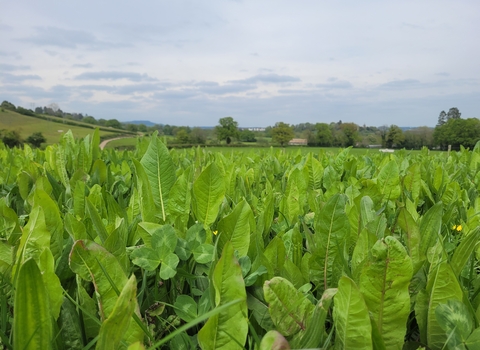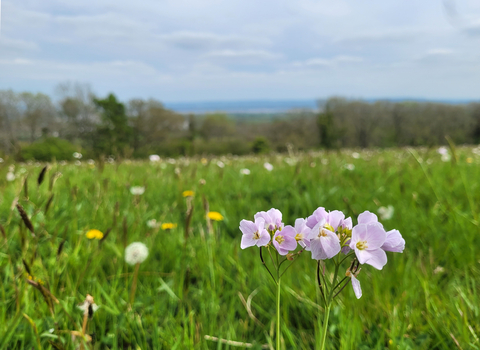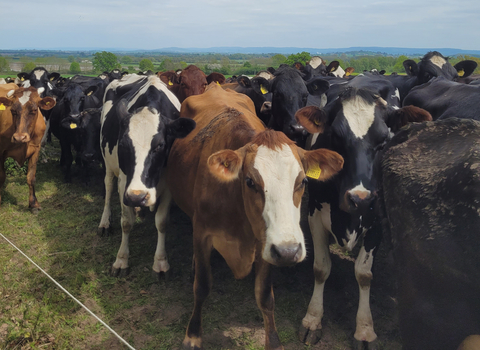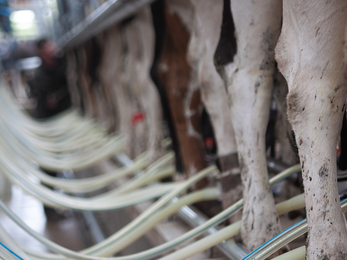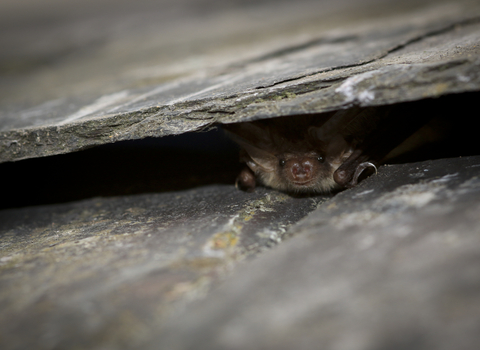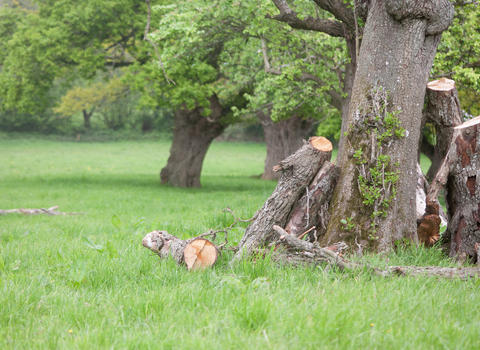Ruddle Court is a 241-hectare mostly grass dairy farm that started in 2017 and is rented under a 25-year Farm Business Tenancy. The whole farm is registered as organic with Organic Farmers and Growers (OF&G) as the certifying body. All the fixtures such as cattle housing, buildings and parlour are newly built by the tenant and will be written off to zero by the end of tenancy.
The 350 milking cows are small size to suit a largely forage-based diet; they are a mix of New Zealand Friesian and kiwi cross cows, aiming for an adult size of 500 kilograms. They’re housed only to protect the land when too wet to carry the cows. There is a very extended grazing system, and this year (2022) due to dry conditions grazing started in January. The farm uses a strip grazing system to ration the forage behind an electric fence. The grazing is followed up by a low slurry application so the nutrients in the slurry are all taken up by an actively growing plant. The slurry is tested for nutrients so that application rates are targeted to meet the needs of the grass growth.
The productive grassland is almost entirely legume and herb rich leys containing a mixture of species including red clover, plantain, chicory, burnet and yarrow. These leys fix their own nitrogen from the atmosphere as no artificial fertilisers are allowed in organic systems. They have high growth rates and the resulting forage either grazed or as silage is higher in protein than a straight grass-based diet.
Purchased feed costs are high at present in particular purchased proteins. The high protein from the mixed species and clovers in the leys reduce the need to purchase in this protein, and the forage provides for adequate growth rates and milk yields with minimal supplementation. The species mix in the leys was determined by individual trial plots of plants to determine which species grew well on the farm, the findings have resulted in an ideal mix that suits the farm and grazing system.
The reseeding of the new leys is carried out beneath a spring barley crop to suppress weed growth; in a practice known as under sowing. The herbal ley mix is sown just after the spring barley seed is drilled. The barley is then cut for an arable silage crop rather than allowed to mature into a combinable grain, this means the cover is removed before it adversely impacts on the grass ley establishment.
The farm also has areas of permanent pasture including 40 hectares of priority habitat for lowland meadows, known as Blaize Bailey. This is a species rich area manged under a stewardship agreement and is grazed only after mid-July to protect the flowering plants in the grassland. It is used as dry cow grazing only, the herd is autumn calving. The low grazing quality with the timing of grazing suits the farming system as it prevents the dry cows from becoming too fat with the associated calving problems. The whole herd grazes here in the autumn and even calves outside to reduce calf disease risk.
The herd is autumn calving which may seem strange for a forage-focused herd, however the milk supply contract favours winter milk and as the farm is often dry in late summer and autumn making this a good time to dry off the herd ready for calving.
The calving period is very tight in a 10-week block from September to early November. This is achieved by exceptionally good heat detection by regular cow inspections and by using heat detection patches glued onto a cow’s back. The farm achieves a commendable 90% 6-week in calf rate - way above the national average (this is the percentage of the herd that gets in calf during the first 6 weeks of mating). All service is by AI and no cover bull is used.
The short calving period means the farm is very busy in September and October when there can be up to 20 calves per day. Following calving, the cows are usually housed over November and December.
The farm sits in a significant feeding area for greater horseshoe bats, there is a maternity roost not far away at Dean Hall and winter hibernacula in local old mines and railway tunnels. They feed over grassland and dung beetles are an important part of their diet.
The veterinary products, known as avermectins, used to treat internal parasites in the cows leave residues in the dung pats that negatively impact insect life including the dung beetles. Ruddle Court Farm does not routinely treat cows with wormers, with the only animals receiving them are the replacement heifers that do not hit expected growth targets in their first year. The farm is trying out alternative products for efficacy against internal parasites that do not have a negative effect on the dung beetles.
The grazing of Blaize Bailey rather than cutting is important for the bats as it provides the necessary dung for the beetles, providing an ideal hunting ground over species-rich grassland.
Chris has found that managing the farm to support the bats has fitted well into his farming systems.
New hedgerows have been planted, and hedgerow trees are encouraged. Hedgerows are throughput the farm and are cut on a rotation to allow blossom, berries and fruit to thrive. Reduced cutting frequency has been brought on-board, and being allowed to grow tall also provides shade for the cattle as well as providing berries, nectar and fruit for wildlife.
There are many in field veteran oak trees throughout Ruddle Court, retaining a parkland look.
An orchard at the top of the farm has been restored with help from Gloucestershire Wildlife Trust and funding kindly supplied by Severn Trent Water. There were a few very old perry pear trees remaining which have been pruned as part of the project to prolong their lives and all the dead wood has been retained on site. Extra orchard trees have been planted well-spaced to create a traditional orchard appearance, and the grass between the trees is grazed by the cows. It is old permanent pasture with no recent record of ploughing. The lower digestibility of this grazing does shows up in cow performance as a lower milk yield - the 1.5 litre reduction per cow per day in yield is a loss of income of over £200 per day in milk sales. To reduce this Chris mixes up the grazing periods in the orchard with grazing his legume and herb rich leys.
What are the challenges?
The main challenge so far has been in growing sufficient forage for the cows. Chris is only in the fourth year of running the herd at Ruddle Court and the levels of phosphate and potash (the common name given to a group of minerals and chemicals that contain potassium) in the soil were very low when he took over the tenancy. These have been improved by making better use of available slurry and manure - the content is analysed before being spread often and at low rates around the whole farm.
Rainfall is low at 750mm (29.5 inches), but the use of the legume and herbal leys will help maintain summer yields as they contain deeper rooting plants such as the red clovers and chicory. The problem months have been July August when forage has been tight.
The farm is on red sandstone derived soils which are often low in minerals. Blood profiles taken from the cows show a lack of selenium and iodine, so these minerals are supplemented in the diet to maintain herd health.
The immediate future for Chris is to keep the farm financially viable in the face of rising costs. His plan is to pay of all debts in the first 12-14 years of the tenancy. This is the first year the farm has broken even after three years of managing the farm.

